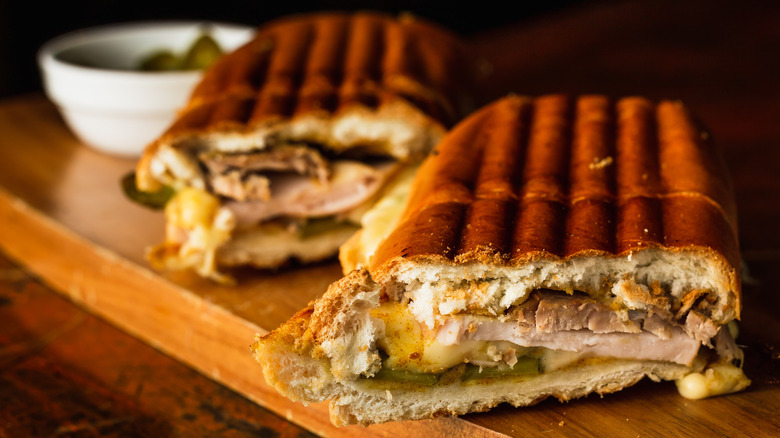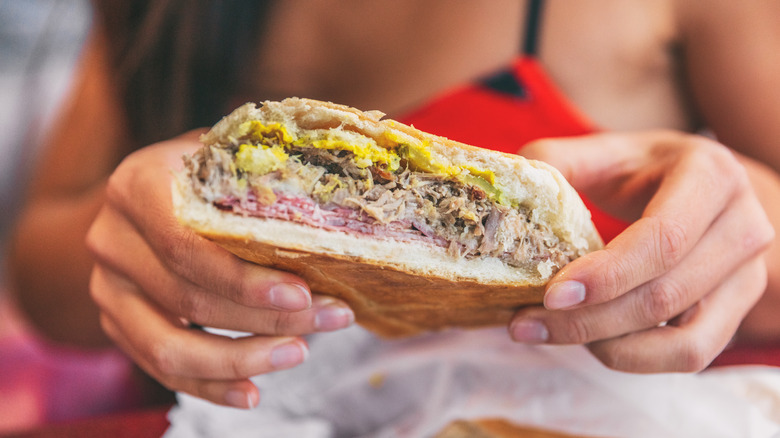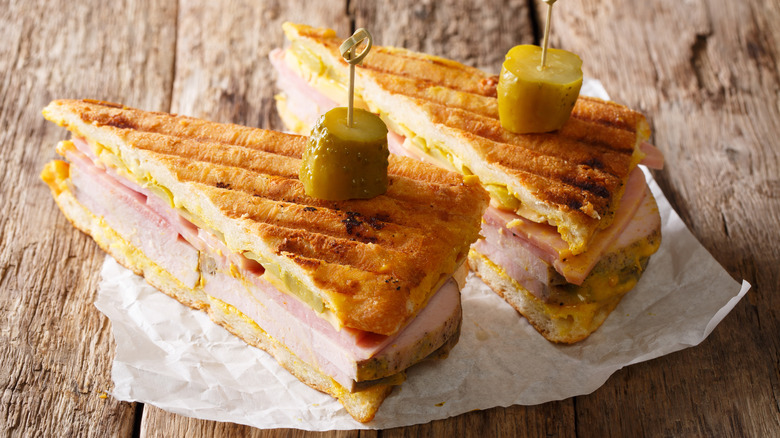The Clever Hack For Making Cuban Sandwiches Without A Panini Press
Some home cooks might dream of outfitting their kitchens with all the gear and technology of a professional kitchen, but most of the time, there's really no need. Don't be fooled, there are useful and affordable kitchen tools out there that every kitchen should have, but most gadgets probably aren't worth the money or lost counter space. Instead, finding quick and easy kitchen hacks is usually the best way to go.
If you're someone who loves to enjoy a really good Cuban sandwich at home, then you might think you need to invest in a panini press first, but that isn't the case. All you really need are two cast iron pans. As long as the smaller pan can nest inside the larger one, you can preheat them together, then combine them into an improvised sandwich press. Just assemble the sandwich while they heat together on the stove, then safely press your Cuban sandwich between the two hot pans. The weight and residual heat should be more than enough to get the classic crispy character that makes Cuban sandwiches so beloved.
The traditional way to press Cuban sandwiches
Pressing your sandwich might seem like an extra and unnecessary step, but it's actually one of the Cuban sandwich's defining characteristics. As restaurant owner Dana Neville told Thrillist, a lot of elements can affect the texture of the bread that a Cuban sandwich is served on, but giving it a quick press turns the exterior crispy while also heating the wonderfully soft interior. Additionally, according to Neville, the best way to press a Cuban sandwich is on a plancha.
A plancha is, traditionally, a style of Spanish cooktop that is often used for grilling and searing meat and seafood. Typically, the heat is concentrated in the center to provide a variety of cooking temperatures (on the sides) for chefs to utilize, and the surface is domed slightly to allow grease to run off its sides. In the case of the Cuban sandwich, though, a plancha can simply be two flat-surface griddles that the sandwich is pressed between. A panini press is often used, too, giving the bread its signature char lines. The plancha's flat surface usually means no char lines, but it's still a favorite for Cuban-sandwich aficionados in cities like Tampa and Miami, where the sandwich rose to fame.
Regional variations of the Cuban sandwich
The earliest form of the Cuban sandwich came from its namesake country, but the two cities most famous for it now are both in Florida: Tampa and Miami. For decades, each one has claimed to be the originator of this legendary sandwich. The two even have different versions of the Cuban sandwich that are separated by a single ingredient.
The Miami version of the Cuban sandwich consists of pork, ham, pickles, mustard, and Swiss cheese on Cuban bread. Where the Tampa variation differs is in the inclusion of genoa salami. The story goes that Cuban immigrants came to Tampa to work in the growing tobacco industry near the city. They brought their beloved sandwich recipe with them and, as they mingled with the region's predominant Spanish and Italian populations, genoa salami was added to the mix. The city of Tampa even made a move to later rename their version of the sandwich to the "Historic Tampa Cuban Sandwich" in order to help it stand out from its competitor.


